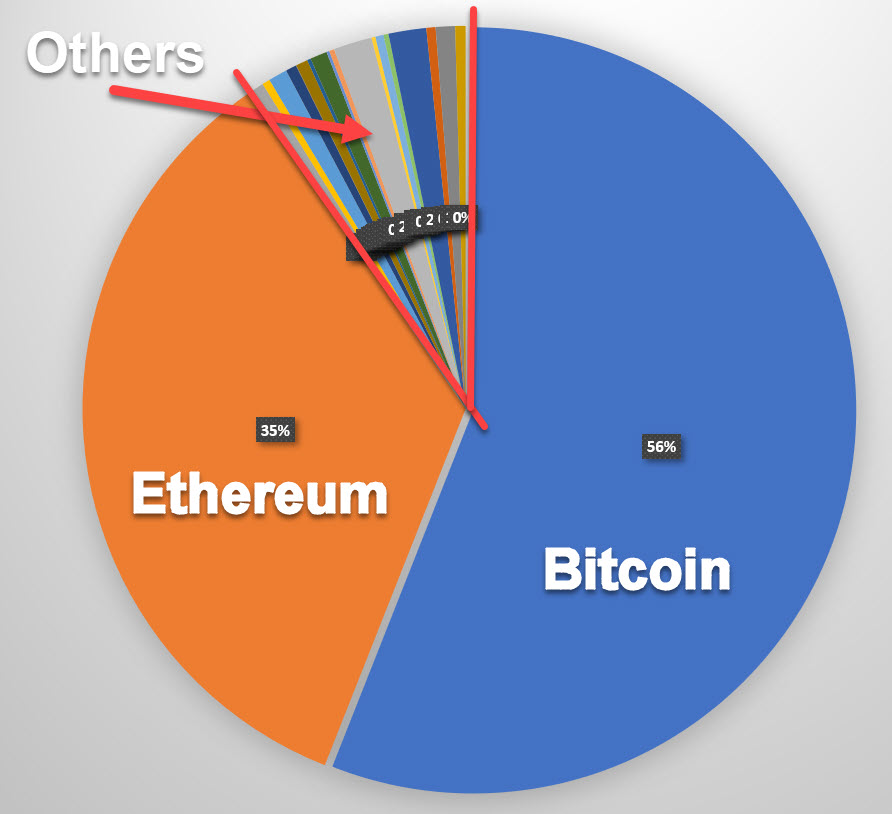A Basic Primer On Crypto Portfolio Allocation
How do you decide how to allocate your crypto portfolio?
What do we even mean by this?
The word portfolio simply refers to your overall collection of investments. The phrase portfolio allocation refers to the percentages of your overall portfolio that go into certain investment classes.
When it comes specifically to a crypto portfolio allocation, it would mean the percentages of your overall portfolio holdings that are in different coins.
I’m going to give you my personal opinions on portfolio allocation here. But, bear in mind… there is no right or wrong way to do this. It comes down to your own personal preferences.
How Much Of Your Overall Portfolio Should Go Into Crypto?
Typical components of an investment portfolio might include stocks, real estate, commodities, bonds, precious metals, etc.
And it is up to you how much you invest into each.
Many people have a retirement account, for instance, that represents much of their investment portfolio. That retirement account is often mostly allocated toward the stock market.
Some hold portions of their portfolio in real estate. Others hold portions in precious metals as a way to put a hedge in against inflationInflation is the rate at which the value (or buying power) of a currency drops over time. The result is that the prices ....
How much of your overall investment portfolio should go into cryptoassets?
Truth is, we’re still pretty early in the overall market cycle for crypto. A lot of people don’t really get it. Or they’re scared of it because of it’s volatility. Or… they don’t even know how to buy it because it doesn’t (yet) show up in their brokerage accounts as something to buy.
So, most people hold NO crypto. That would be a 0% allocation.
However, I think we’re at a point now where it is simply smart to hold at least a small allocation of your portfolio in cryptoassets.
Now how much that is… you need to decide.
Most say to keep it small. Perhaps anywhere from 1-5% of your overall portfolio into cryptocurrencies. Jim Cramer recently said on his Mad Money show that he recommends about 5% in gold… and about 5% in Bitcoin.
Most people who have been investors for awhile will typically not recommend any more than about 5% exposure to the crypto markets. Enough to be able to profit from it, but small enough to respect the volatility and unpredictability of the market without potentially wrecking your overall portfolio.
Now, some people have much more than that.
Personally, I have almost half of my total net worth in cryptocurrency right now. Of course, it didn’t start that way. It grew to become that.
Also, I’ve willingly swallowed the red pill when it comes to this stuff. I strongly believe in what this new asset will become so I’m pretty “all in” on it. My risk tolerance is pretty high, too.
I understand, though, that most people won’t be comfortable with that. So, I am pretty comfortable agreeing with the likes of Cramer in saying that about 5% of your portfolio can go into crypto.
If you’re younger, more comfortable with risk, then perhaps go higher than that.
In the end, you have to go with what you’re comfortable with. As the reliable rule goes…
Never invest more money than you could afford to lose.
How Should You Allocate Your Crypto Portfolio?
So, how should you split up your funds?
Should you go all in Bitcoin, or split it up and buy some of the others, too?
First, ask yourself…
How Tolerant Of Risk Are You?
First off, it takes a certain risk tolerance to be comfortable getting into crypto at all. The asset class is new, certainly has some speed bumps ahead of it, and is pretty volatile.
If you prefer the slow-and-steady approach and the idea of losing any money just makes you sick, I recommend to avoid crypto. For now.
But, if you’re OK getting into this market, you need to decide just how deep into this pool you’re comfortable getting.
For less risk tolerant crypto investors, I would recommend you stick with Bitcoin and Ethereum.

Both of these projects are quite proven. While nobody can guarantee anything, I think the market penetration of these two coins will give you about as much stability as you can expect in the crypto market.
For awhile, I personally held a 65/35 allocation. 65% of my funds were in Bitcoin, 35% in Ethereum.
As my knowledge of the market improved, I changed it around.
For Smaller Crypto Accounts…
If the overall amount of money you have in crypto is fairly small, I would recommend you stick with Bitcoin and/or ETH.
So, if you’re going to invest $1,000, put $650 in BTC and $350 in ETH. You get the idea.
Most people start with 100% Bitcoin and that’s fine, too. Usually Bitcoin is the “gateway coin” for this space. ETH is very frequently the second coinSometimes referred to as a token, or a coin. The two terms are used pretty interchangeably. Essentially, it is a digital... people buy.
If you’re comfortable with Ethereum, than you may want to consider a 50/50 split, since I personally think ETH has more potential upside to it than Bitcoin.
For Larger Crypto Accounts…
Once again, it comes down to your level of risk tolerance.
Personally, my portfolio breaks down as follows:
- 55% Bitcoin
- 35% Ethereum
- 10% in various Altcoins
I know, technically, ETH is considered an altcoinAny cryptocurrency other than Bitcoin. Since Bitcoin was first and is the market leader (in terms of market cap), the ve.... But, I don’t consider it to be, at this point. I consider all coins other than BTC and ETH to be “alts”… and about 10% of my overall portfolio is in those.
Now, some crypto investors are more risk tolerant. The higher your risk tolerance, the more you might want to dedicate to the altcoins.
Usually, those altcoins are newer, have lower market caps. But, some have the potential to be huge projects and turn small amounts of money into larger amounts. Thing is… they could also turn into nothingburgers. 🙂 So, you need to do your own homework on these coins before you invest in them.
The more experienced crypto investors sometimes lean more heavily into the altcoins. While I have about 10% currently, they may lean toward 20%, 30%… or even 50%.
Keep in mind, many still consider ETH to be an altcoin, so may include that in their allocation into altcoins. If I did that, I’d be about 45% into altcoins right now.
Most still own a fair amount of Bitcoin, however, since many coins require that you hold Bitcoin to buy them, It would be really odd to be involved with crypto and not hold any Bitcoin. 🙂
Rebalancing A Portfolio
From time to time, you might need to rebalance your portfolio.
As coins rise and fall in value, the percentage breakdown of the portfolio could change. When this happens, you may want to take the time to rebalance it back to your allocation strategy.
For instance, I recently rebalanced my own to get up to 10% allocation to altcoins. I found I was too heavily into BTC and ETH and I didn’t feel I had enough exposure to the new DeFiShort for Decentralized Finance. It is a brand new breed of finance that provides typical financial services in a decent... trend and some other projects. I only had 5-6% of my portfolio in those projects and I decided to increase it.
In my case, I left my ETH alone. But, I decided to sell some of my Bitcoin and buy some other projects with it.
So, using Bitcoin, I went and purchased some new coins that I had researched and decided I want to take part in. I put no new dollars into the portfolio. I simply… moved some things around.

I track the portfolio in a spreadsheet and it gives me the percentage of my overall whole that I have in each coin. Using this spreadsheet, I acquired some other coins with enough BTC that I brought my allocation of BTC down and moved it into some new altcoins. Once I had roughly 10% in those alts, I stopped.
If my predictions pan out in those altcoins, my portfolio could end up being in a situation where one (or hopefully a few) of those coins end up being big parts of my portfolio and the overall sum is way more than 10%. If that happens, I’ll then do a new rebalancing. Likely, selling off some of it (or “taking profits”) and either move it back into Bitcoin, or even cash out some of it and do put it into something non-crypto.
Likewise, there could come a time when I want to re-balance so as not to be so heavily into the crypto market overall. I fully expect that to happen, in fact. When the time comes, I will likely be moving some of the capital from crypto and invest it into real estate.
Tracking Your Portfolio
It is helpful to know what your allocation percentages are in your portfolio. It helps to use some kind of tool to help you keep track of it.
It is a pretty simple calculation, really. Just list out each of the coins you own, their current market value, and how much you own. This will give you the market value of each of your holdings.
Then, for each, track what the percentage is compared to the overall value of all of your crypto.
If you keep your crypto all in one walletWe know a wallet as a thing you keep your money in. In cryptocurrency, we use the word wallet to refer, likewise, to a p..., then most of them will give you this information built into the interface.
Where it gets more complicated is if you have funds spread out among multiple wallets and exchanges.
I personally track my portfolio using CoinTracker. It allows me to track my portfolio across all exchanges and wallets all in one interface. Some other tools would include:
- Blockfolio
- Delta
- CoinStats
- Crypto Pro (Apple products only)
I use my own spreadsheet to track my coins. Google Sheets can be quite useful in this regard because it as some nifty add-ons that make it easy to bring in dynamic prices for coins. I use Excel, myself. You can check out CryptoSheets as an Excel add-on for importing crypto prices.
That’s The Summary
My aim here isn’t to make this complicated or get into various people’s opinions on how to do portfolio allocation.
Clearly, how people choose to do this has a lot to do with their strategy and how tolerant of risk they are. There’s no right or wrong way to do it.
I hope I gave some simple benchmarks by which you can judge your own portfolio.







